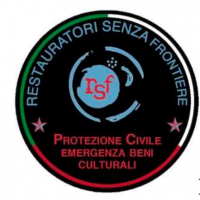
The Association “RSF Civil Protection Cultural Heritage” pursues the protection and preservation of historical, artistic and cultural heritage in cases of disasters and natural disasters in the Civil Protection and Cultural Heritage Emergency.
The association’s main statutory activities include:
-Research and training in civil defense activities;
-Activities and interventions aimed at the protection of cultural property
-Prevention and monitoring of cultural property, in cases of emergency in territories exposed to seismic risk or other disasters.
-Preservation of environmental heritage;
It also carries out public awareness and information activities and cooperation with institutional bodies and other entities pertaining to its social purposes, as well as engaging in specialized training.
THE ASSOCIATION
RSF Civil Protection Cultural Heritage was established on February 18, 2017, renewing and expanding the bylaws and purposes of the RSV San Polo dei Cavalieri association, which already gathered volunteer restorers with 20 years of experience in activities and interventions to safeguard, recover and restore cultural and environmental assets at risk or damaged as a result of natural disasters.
Following the earthquake that struck central Italy in 2016, a group of associates felt the need to better structure operations and involve a greater number of volunteers to ensure a coordinated contribution within the Emergency Cultural Heritage Civil Protection on the very serious damage to the historical and artistic heritage inflicted by the earthquake in the territories of Lazio, Umbria and Marche, and also envisaging future missions of this kind.
Therefore, in the transformation and expansion of the social purposes, an area of specialization on cultural heritage was identified within the Civil Defense.
The Association also accepted the proposed affiliation to the “Coordination of volunteer organizations” Lazio Region.
ACTIVITIES
2017 to present
Lviv (Ukraine), 2022 – Museums inspection and Fund Raising campaign launch (with Save Ukraine Art 22)
Restauratori Senza Frontiere Italia has been an active and proactive part of the Save Ukraine Art 22 Project from the very beginning to safeguard works of art in the war-torn land of Ukraine.
After the presentation of the project in Venice on May 31, 2022, during the summer RSF Civil Defense carried out a site visit to Lviv to view and assess the status of operations to save and secure the works of art.
Given the extremely difficult situation of the Ukrainian work team, RSF then proposed to Save Ukraine Art 22 a Fund Raising initiative to collect materials and equipment for urgent or planned restorations interrupted due to the war.
As part of this, RSF is immediately helping to send initial essential materials, such as painterly retouching paints, and is acting as a spokesperson for the initiative, making itself available to use its website as a platform for fundraising.
Jerusalem, 2021-2022 – Securing and moving archaeological artifacts from the Holy Sepulcher.
Five monumental columns and two Corinthian capitals, removed in 1969 from the Basilica of the Holy Sepulcher in Jerusalem because they were unstable and relocated to the Garden of Gethsemane, have been under the care of the Restorers Without Borders team for a year as part of a project sponsored by the “pro Terra Sancta” association. Investigations carried out on the artifacts, which are more than 1,500 years old and weigh more than 4 tons each, had revealed very serious static problems, so initial consolidation was necessary before transporting them to the archaeological museum of the Custody of the Holy Land .
Following the transfer, the pieces were displayed and restoration will be completed.
Norcia (PG), January – March 2017 – Basilica of St. Benedict – Recovery and selection of rubble
From January 9 to March 27, 2017 volunteers from the association collaborated with the Central Superior Institute for Restoration of the Mibact in the recovery and selection of rubble at the Basilica of St. Benedict. During the intervention, rubble removal operations were completed. The intervention involved sorting the rubble into three categories: A (most valuable), B and C (of no interest). In the course of the intervention, volunteers provided assistance to the firefighters, also working with the ISCR to define the design aspects, procedures and the most suitable methods to be adopted.
Some past experiences of volunteers
L’Aquila, April – May 2009 – Municipal House, Palazzetto dei Nobili, Church of Santa Maria del Soccorso in the Cemetery: recovery, initial securing, packing, transport to storage and filing of movable works.
In coordination with the Municipality of L’Aquila and the Consortium BB. CC., under the supervision of the Superintendency and the technicians in charge of the artwork recovery missions, the volunteers took care of packing and first securing the works, including care in transporting them to a safe place. Following the prompt intervention, volunteers worked on further steps such as asset cataloguing and photographic documentation.
L’Aquila, December 2009 – Church of St. Sylvester: recovery of fallen fresco fragments and preliminary securing of pictorial pieces.
After elaborate data collection on the state of conservation of the works using a camera system based on immersive photographs, the intervention focused on recovering all the shattered portions of the fresco that had fallen to the ground, which were selected and deposited in special boxes. An archaeological-type system was imprinted to collect the fragments of the wall paintings through a ground grid with progressively numbered boxes to locate the fragments on special maps and thus catalog their recovery facilitating reconstruction.
Two seismic tremors occurred during the course of the intervention, with the need to accelerate the securing of the decorative apparatuses still in situ in the areas at greatest risk of falling. The prompt intervention was carried out by applying layers of velatin with an acrylic resin on the areas of painted plaster that were unsafe and at greatest risk, in order to prevent further losses.






